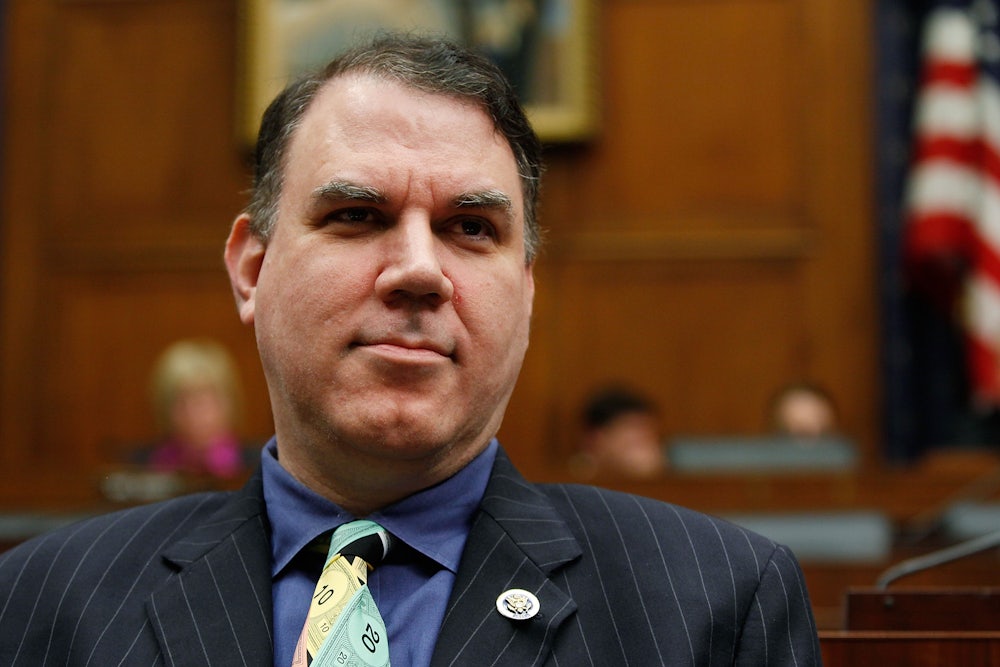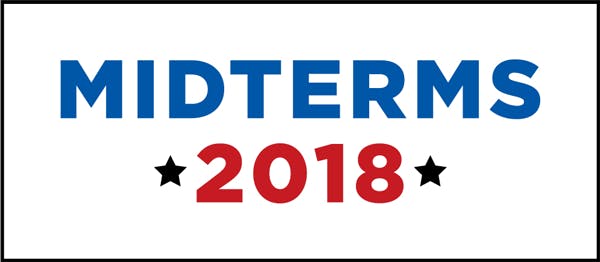In September of 2009, Alan Grayson—a freshman Democrat from Central Florida—stood in the well of the House, flanked by an easel, and told Americans that “if you get sick … the Republican health care plan is this: Die quickly.” The brief performance propelled him into the media stratosphere. Soon, he was a regular on the Capitol Hill talk shows, MSNBC in particular, denouncing Dick Cheney as a vampire, a lobbyist as “a K Street whore,” and, later, the Tea Party movement as a modern incarnation of the Ku Klux Klan. “If the hood fits, wear it,” Grayson repeated to those who pushed back. The more his targets railed against him, the more his base cheered—and sent him contributions. In the day after his “die quickly” speech, he raised $114,108.
Almost a decade later, Grayson has largely disappeared from the Washington spotlight. Two years ago, he gave up the House seat he’d occupied off and on since 2009 to run for Senate, vying for the seat that Marco Rubio had said he was giving up. Grayson didn’t even get the Democratic nomination. Thanks largely to the Democratic Senate Campaign Committee, Patrick Murphy, a centrist congressman from South Florida, who crushed Grayson in that August’s Democratic primary (and went on to lose in November). Now, Grayson has launched a bid to win his old seat back from his successor in the House, Congressman Darren Soto, a moderate Democrat. And while he may not win the August 28 primary, the race—perhaps the last act in his tumultuous political career—says a lot about how much the Democrats have evolved in the decade since he first entered politics.
In 2009, Grayson occupied a unique place within the party, both on policy and in politics: He was on its far left flank, pushing the Democrats in that direction on key policies, the Affordable Care Act among them. Today, however, many Democratic voices are articulating and advocating an unabashedly liberal agenda, one even further to the left than what Grayson advocated 10 years ago. Moreover, back then, he filled a prominent, even needed, role as a designated Democratic bomb-thrower, the only person willing to push back against tepid, liberal pragmatism and criticize the GOP. But now, with an unpopular president in the White House, many Democrats, from newcomer Alexandria Ocasio-Cortez to veterans like Maxine Waters, Nancy Pelosi, and Adam Schiff, have taken that role upon themselves. They’ve abandoned “civility” for the more aggressive style Grayson pioneered years ago. If he has left a mark on the party, the party, it seems, has only passed him by.
To say Grayson is not a favorite of the Beltway Democratic establishment would be a titanic understatement. In his pre-candidate days, when he was a successful trial lawyer—winning headlines for suing corporate profiteers during the Iraq War on behalf of whistleblowers—Grayson was a courted party donor. That changed when he arrived in Congress in 2009.
Almost from the start, he alienated colleagues, staff, and lobbyists of both parties—even erstwhile allies. Critics describe Grayson as a man of towering ego and arrogance, which he dismisses as justified self-assurance. When talking to journalists, always off the record, those who knew him then use various pejorative metaphors for this hostility: thorn in the side, stone in the shoe or—the consensus pick—simply a self-righteous pain in the ass.
At the Democratic National Convention in 2016, just as his Senate campaign appeared to be gaining traction, his estranged wife leaked police records from Northern Virginia and Florida, accusing him of domestic violence, to Politico. Questioned about the charges by a Politico reporter, a sweaty, clearly unhinged Grayson got into a shoving match with him and threatened to have him arrested by Capitol Police. Several liberal groups that had endorsed him immediately rescinded their backing. And even though the reports were never authenticated—and in fact, Lolita Grayson later admitted to having fabricated them—their mere existence two years later, in the #MeToo era, could be tough to overcome.
There’s another reason Grayson seems so out of touch with his party today. In his last two terms, from 2013 to 2017, he pulled off a stunning transformation into an effective legislator, developing a productive relationship with the Republican House majority. By his count, he passed or sponsored more than 100 bills, resolutions and amendments, many of which were enacted into law in some form. These included measures that shielded homeowners from predatory mortgage foreclosures and provided free tax preparation assistance for seniors. Grayson’s work led Time magazine to list him among the five most productive bill writers in both houses. Slate magazine put it this way in a headline: “The Congressman Formerly Known as Crazy: Why Alan Grayson is now the most effective member of the House.”
Today, with Democratic activists now calling on their representatives in Congress to “resist” everything the GOP does, Grayson’s history of cooperating with Republicans puts him in awkward, contradictory territory—even more so now, as he hits the campaign trail trying to highlight just how leftist he actually was all along.
There’s no question that Grayson stands to Soto’s left. Soto has accepted money from the sugar industry, utility PACs, and even Education Secretary Betsy DeVos’s family. As a state legislator, he once voted to prosecute abortion as murder, and backed Stand Your Ground legislation drafted by the gun lobby, leading to an NRA endorsement. Soto has since tried to walk back these positions, especially after the Orlando Pulse nightclub and Parkland shootings. But Grayson has still been using those stances to draw out some strong contrasts, campaigning on gun control, reproductive choice, public schools, and, to a lesser degree, the impeachment of President Donald Trump. He is an outspoken and consistent proponent of all four. In a July 4 email blast to his supporters, he wrote, “I look forward to impeaching him, convicting him, and removing him from office.” Around the same time, the first of several billboards went up in the district—seen by more than 50,000 drivers daily—urging Americans to “Dump Trump” by voting for Grayson.
These aren’t unusual positions for a Democrat running in a contested primary. But to hear Grayson talk, you might think he was the second coming of Ocasio-Cortez, a political newcomer running against some Democratic Party machine man.
When I had lunch with Grayson at a restaurant near his home in the affluent Dr. Phillips area of Orlando last month, he was leaning into the idea that his race was another chapter in the tussle between the Democratic Party’s center and left. If he wins, he told me, “the party will have to come to grips with the fact that the leading champion in the country for increased wages, Social Security and Medicare knocked off an incumbent Democrat.”
These parallels can be overstated. It’s true that Grayson has received an endorsement from a local group affiliated with Our Revolution. But Central Florida is not the Bronx, and, unlike Ocasio-Cortez, Grayson is no socialist. He has made expanded health care, “Medicare You Can Buy,” a centerpiece of his campaign, but that hardly seems radical in a district with a lot of seniors. To this, he proposes adding his own supplementary legislation, “Seniors Have Eyes, Ears and Teeth,” which would broaden Medicare coverage—as well as his own, across-the-board raise, called “Seniors Deserve a Raise.”
“Grayson is more progressive [than Soto], but I don’t think this primary is going to be determined by who is the most progressive on a set of issues,” says Rollins College political scientist Donald Davison. Lots of Democrats are touting such platforms now; Grayson isn’t the only one. Besides, there are more important, structural obstacles he would have to overcome to win the district.
Grayson was defeated in the 2010 Tea Party wave, but returned to office two years later in a redrawn 9th congressional district, designed to make it more favorable for a Hispanic candidate. Today, it stretches from Eastern Orlando into the working class suburbs to the South. Across the district, Hispanics, mostly from Puerto Rico, now account for 41 percent of the voting age population. Two years ago, they elected Soto—whose father was born in Puerto Rico, a fact he never fails to mention in stump appearances and in his campaign advertising—by a resounding margin. That year, he won the general election with 57.5 percent of the vote, becoming Florida’s first member of Congress of Puerto Rican descent.
Grayson has done everything he can to portray Soto as a “bootlicking lackey of the NRA,” a “professional poseur,” and “pustule on the hindquarters of American politics,” which, when asked, he says he intends to lance. Soto’s policies are “about as good as conservatives can hope for from his liberal democratic district,” according to the Sunshine State News. But with the district composed the way it is, that hasn’t really mattered. As the incumbent, Soto has most of the local, progressive endorsements that once went to Grayson. And, given the support he enjoys from the Beltway elite, observers believe he is a strong favorite to win the primary. The outcome may depend on which candidate has the more effective turnout operation.
But there is, Davison told me, a larger question at stake in this race: “What is the Democratic Party today? What is its ideology?” He believes that it’s “much more a collection of distinct identity groups, and less a party of ideology … better characterized as a party of policy pragmatists, one that is a much more culturally, racially ethnically diverse coalition of groups and their interests around the country.”
Many Democrats have pushed back on such thinking since the 2016 election, arguing that identity politics isn’t enough to bring the party back to power at the national level. But in a place like Central Florida, that may not be the case. There, it’s Darren Soto—this bland, soft-spoken, inoffensive, malleable centrist—not Alan Grayson, who appears to have the best shot at winning the Democratic nomination.
And if Grayson loses? Would this be the end for him? Maybe not, said Jim Clark, a political historian at the University of Central Florida. “I think he could become a perennial candidate.… It doesn’t matter whether he wins or not. I would not be surprised to see him jump into the 2020 presidential race!”

